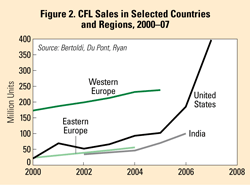CFL Sales Skyrocket
 This new snapshot of CFL lighting trends includes detailed figures on worldwide sales as well as an analysis of the associated environmental benefits. It reveals that:
Lighting consumes roughly 19 percent of all electricity produced on the global grid and is responsible for carbon emissions equal to those produced by half of the light passenger vehicles in the world. This article explains why CFLs, despite their trace mercury content, are truly a "greener" source of light, and outlines what the next revolution in lighting may be. Read the Vital Signs Update: Strong Growth in Compact Fluorescent Bulbs Reduces Electricity Demand |